Menu
Physics Lesson 14.2.2 - Resultant Force Acting on a Charge When all Charges Are Collinear
Please provide a rating, it takes seconds and helps us to keep this resource free for all to use
Welcome to our Physics lesson on Resultant Force Acting on a Charge When all Charges Are Collinear, this is the second lesson of our suite of physics lessons covering the topic of Coulomb's Law, you can find links to the other lessons within this tutorial and access additional physics learning resources below this lesson.
Resultant Force Acting on a Charge When all Charges Are Collinear
Let's consider the situation when three charges are at the same line and the resultant force acting on the middle charge is required. Look at the figure below.
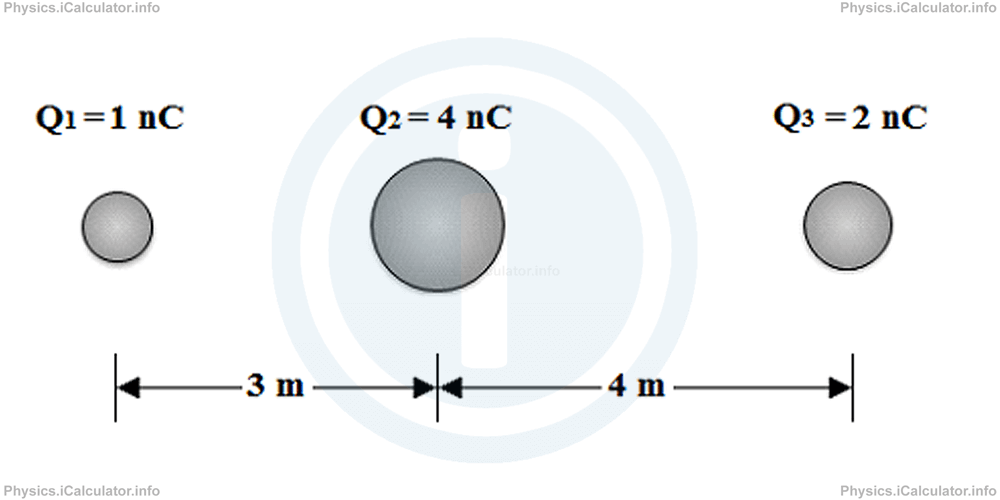
All charges are positive, so they exert a repelling force on each other. If we are asked to calculate the resultant force acting on Q2, we must find the force exerted by Q1 on Q2 and the force exerted by Q3 on Q2 separately. Given that 1 nC = 10-9 C, we have:
and
For the first force, we obtain for F1-2
= 4 × 10-9 N
and for F3-2
= 4.5 × 10-9 N
Since the forces are in opposite directions, we have
= 0.5 × 10-9 N
= 5 × 10-10 N
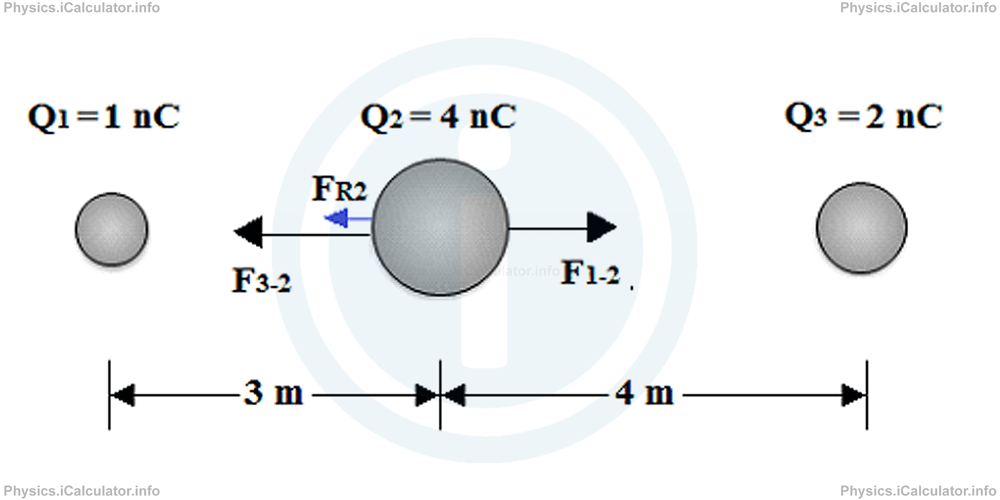
If charges were not of the same sign, the approach would be the same but the result different. For example, if Q3 in the previous example was -2 nC instead of +2 nC, the force F3-2 would be negative, i.e. F3-2 = - 4.5 × 10-9 N. This means the resultant force acting on Q2 would be
= -4.5 × 10-9 N - 4 × 10-9 N
= -9.5 × 10-9 N
The sign minus in the result means the resultant force is directed due right, as shown in the figure below.
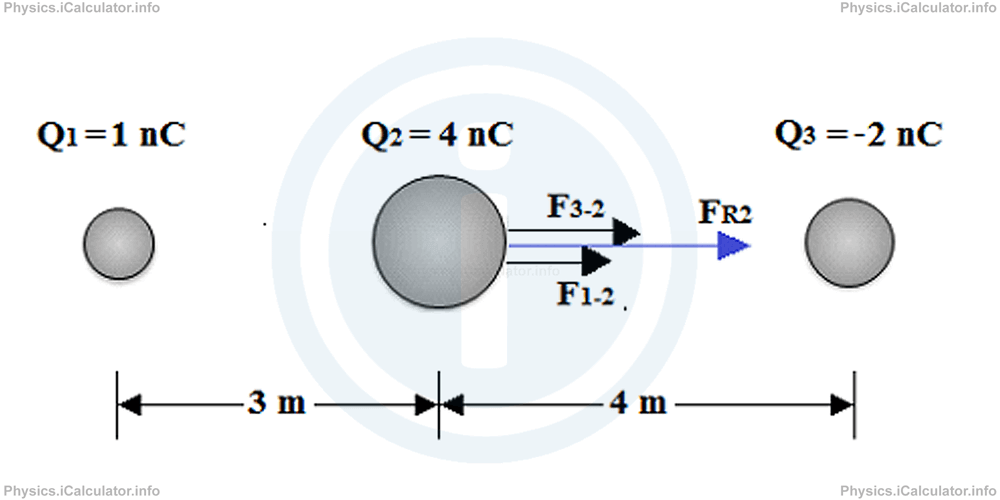
Resultant Force Acting on a Specific Charge When Charges Are Not Collinear
When charges are not collinear, the corresponding forces are not collinear either. In this case, we must consider their components according the basic directions separately and then, calculate the resultant force by using the Pythagorean Theorem. Let's consider an example in this regard.
Example 4
Calculate the resultant force acting on Q1 for the system of electric charges shown in the figure. All charges are in micro Coulombs (μC).
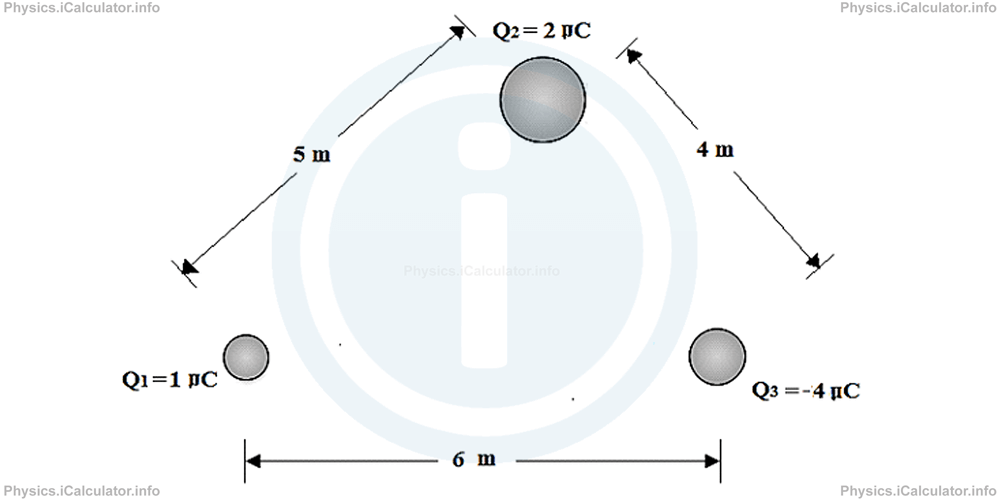
Solution 4
It is easy to calculate F3-1 as it acts only according the horizontal direction. It is an attraction force as the charges Q1 and Q3 are of opposite sign. Thus, we must write the vector of F3-1 directed due right and with origin at Q1. Giving that 1 μC = 10-6 C, we have:
= 9 × 109 × (-4) × 10-6 × 1 × 10-6/62
= -1 × 10-3 N
or 1 × 10-3 N due right of Q1
We can also find the magnitude of F2-1 in the same way. The force is repulsive as both charges are positive. Thus, we can write
= 9 × 109 × 2 × 10-6 × 1 × 10-6/62
= 0.5 × 10-3 N
However, we have more work to do here, as the direction of F2-1 is a combination of horizontal and vertical components.
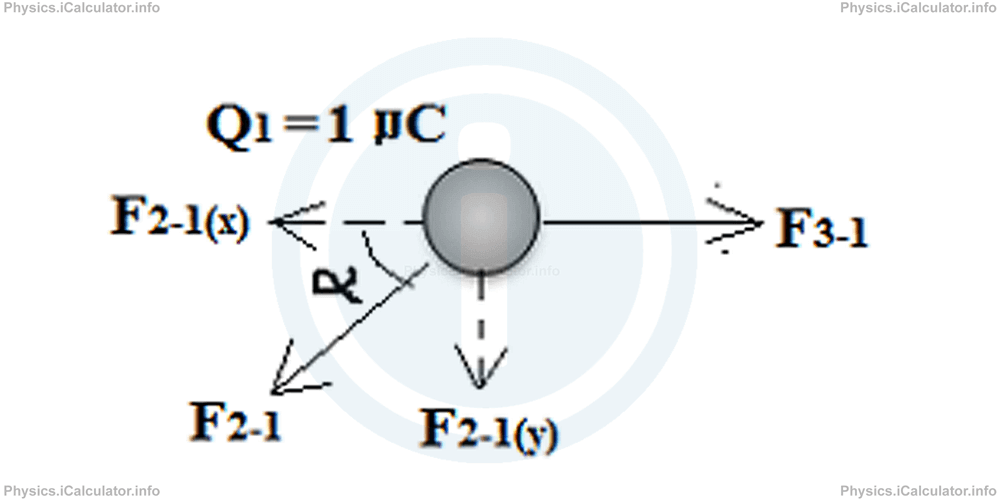
We can find F2-1(x) and F2-1(y) based on the cosine theorem
where a is the opposite side to the angle α and b and c are the sides of the angle. This enables us to find the cosine of the corresponding acute angle formed by the forces (the actual angle is obtuse).
Substituting a = 4, b = 5 and c = 6 in the specific case, we obtain
16 = 61 - 60 × cos α
cos α = 3/4
Also, using the Fundamental Theorem of Trigonometry
we find the value √7/4 for sin α.
Therefore,
= 0.5 × 10-3 N × 3/4
= 0.375 × 10-3 N
Since the actual angle is obtuse, we take F2-1(x) = - 0.375 × 10-3 N. This means this force acts due left of Q1.
We use the same procedure to calculate F2-1(y). We have
= 0.5 × 10-3 N × √7/4
= 0.331 × 10-3 N (down)
The resultant force on Q1 according the horizontal direction therefore is
= 1 × 10-3 N - 0.375 × 10-3 N
= 0.625 × 10-3 N
The resultant force acting on Q1 in the vertical direction is only due to F2-1(y). Therefore, the resultant force acting on Q1 is
=√(0.625 × 10-3 )2 + (0.331 × 10-3 )2
=0.7 × 10-3 N
You have reached the end of Physics lesson 14.2.2 Resultant Force Acting on a Charge When all Charges Are Collinear. There are 2 lessons in this physics tutorial covering Coulomb's Law, you can access all the lessons from this tutorial below.
More Coulomb's Law Lessons and Learning Resources
Whats next?
Enjoy the "Resultant Force Acting on a Charge When all Charges Are Collinear" physics lesson? People who liked the "Coulomb's Law lesson found the following resources useful:
- Resultant Force Feedback. Helps other - Leave a rating for this resultant force (see below)
- Electrostatics Physics tutorial: Coulomb's Law. Read the Coulomb's Law physics tutorial and build your physics knowledge of Electrostatics
- Electrostatics Revision Notes: Coulomb's Law. Print the notes so you can revise the key points covered in the physics tutorial for Coulomb's Law
- Electrostatics Practice Questions: Coulomb's Law. Test and improve your knowledge of Coulomb's Law with example questins and answers
- Check your calculations for Electrostatics questions with our excellent Electrostatics calculators which contain full equations and calculations clearly displayed line by line. See the Electrostatics Calculators by iCalculator™ below.
- Continuing learning electrostatics - read our next physics tutorial: Electric Field
Help others Learning Physics just like you
Please provide a rating, it takes seconds and helps us to keep this resource free for all to use
We hope you found this Physics lesson "Coulomb's Law" useful. If you did it would be great if you could spare the time to rate this physics lesson (simply click on the number of stars that match your assessment of this physics learning aide) and/or share on social media, this helps us identify popular tutorials and calculators and expand our free learning resources to support our users around the world have free access to expand their knowledge of physics and other disciplines.